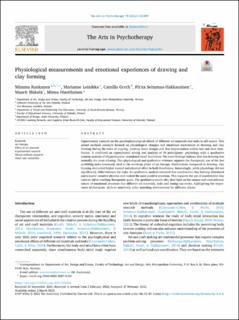| dc.contributor.author | Rankanen, Mimmu | |
| dc.contributor.author | Leinikka, Marianne | |
| dc.contributor.author | Groth, Camilla | |
| dc.contributor.author | Seitamaa-Hakkarainen, Pirita | |
| dc.contributor.author | Mäkelä, Maarit | |
| dc.contributor.author | Huotilainen, Minna | |
| dc.date.accessioned | 2022-10-18T10:01:12Z | |
| dc.date.available | 2022-10-18T10:01:12Z | |
| dc.date.created | 2022-05-25T11:11:55Z | |
| dc.date.issued | 2022 | |
| dc.identifier.citation | Rankanen, M., Leinikka, M., Groth, C., Seitamaa-Hakkarainen, P., Mäkelä, M. & Huotilainen, M. (2022). Physiological measurements and emotional experiences of drawing and clay forming. The Arts in Psychotherapy, 79, Artikkel 101899. | en_US |
| dc.identifier.issn | 0197-4556 | |
| dc.identifier.uri | https://hdl.handle.net/11250/3026594 | |
| dc.description.abstract | Experimental research on the psychophysiological effects of different art materials and tasks is still scarce. This mixed methods research focused on physiological changes and emotional experiences in drawing and clay forming during the tasks of copying, creating novel designs and free improvisation within fast and slow timeframes. It combined an experimental setting and analysis of 29 participants’ physiology with a qualitative content analysis of 18 participants’ stimulated recall interviews. The main findings indicate that fast drawing was mentally the most relaxing. This physiological and qualitative evidence supports the therapeutic use of the fast scribbling tasks commonly used in the warm-up phase of art therapy. Furthermore, compared to drawing, clay forming demanded higher mental and physical effort in both timeframes. Interestingly, while physiology did not significantly differ between the tasks, the qualitative analysis revealed that nondirective clay forming stimulated participants’ creative ideation and evoked the most positive emotions. This supports the use of nondirective clay tasks to aid in reaching therapeutic goals. The qualitative results also shed light on the unique and contradictory nature of emotional processes that different art materials, tasks and timing can evoke, highlighting the importance of therapists’ skills to sensitively tailor matching interventions for different clients. | en_US |
| dc.language.iso | eng | en_US |
| dc.rights | Navngivelse 4.0 Internasjonal | * |
| dc.rights.uri | http://creativecommons.org/licenses/by/4.0/deed.no | * |
| dc.title | Physiological measurements and emotional experiences of drawing and clay forming | en_US |
| dc.type | Peer reviewed | en_US |
| dc.type | Journal article | en_US |
| dc.description.version | publishedVersion | en_US |
| dc.rights.holder | 2022 The Author(s). | en_US |
| dc.source.pagenumber | 1-14 | en_US |
| dc.source.volume | 79 | en_US |
| dc.source.journal | The Arts in Psychotherapy | en_US |
| dc.identifier.doi | https://doi.org/10.1016/j.aip.2022.101899 | |
| dc.identifier.cristin | 2027293 | |
| dc.source.articlenumber | 101899 | en_US |
| cristin.ispublished | true | |
| cristin.fulltext | original | |
| cristin.qualitycode | 1 | |

